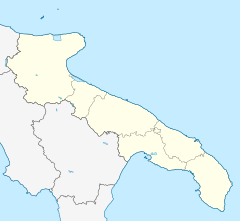Deer Cave (Otranto)
| Grotta dei Cervi | |

|
|
| Alternate name | Grotta di Enea |
|---|---|
| Location | near Porto Badisco, Otranto Comune |
| Region | Province of Lecce, Apulia, Italy |
| Coordinates | 40°5′0.4″N 18°29′15″E / 40.083444°N 18.48750°ECoordinates: 40°5′0.4″N 18°29′15″E / 40.083444°N 18.48750°E |
| Type | limestone karst underground cave complex |
| Part of | Peninsula Salentina |
| Length | 1,500 m (4,900 ft) |
| History | |
| Periods | late Neolithic, Eneolithic, 6000 to 5000 years BP |
| Associated with | prehistoric settlers |
| Site notes | |
| Excavation dates | 1970 |
| Archaeologists | Paolo Graziosi |
| Management | University of Salento |
| Public access | no |
The Deer Cave (Italian: Grotta dei Cervi - literally: Grotto of the stags) is a natural cave at the Salento coast near the town of Porto Badisco, around 8 km (5.0 mi) south of Otranto in Apulia, Italy. Unknown before 1970 it came to immediate international attention after the discovery of its impressive, innovative and enigmatic complex galleries of prehistoric parietal wall paintings.
This complex of underground caves was discovered during an ongoing routine exploration of the local territory on February 1, 1970 by a team of speleologists of the Salento Speleological Group "Pasquale de Laurentiis" from Maglie. It was initially named Cave of Aeneas (Grotta di Enea) in reference to Virgil's Aeneid in which the Trojan hero Aeneas first landed in Italy precisely in Porto Badisco. The current name alludes to the omnipresence and significance of deer depictions among the cave's galleries. The location was soon closed to the public in order to not to disrupt the original environmental conditions essential for the conservation of the paintings. Access to the cave remains restricted to authorized personnel and researchers only.
The Grotta dei Cervi, the Grotta Romanelli and the Grotta delle Veneri are all located in the coastal Karst formations on the Salento peninsula in southern Apulia. Deemed to constitute a notable local cultural continuity of Paleolithic and Neolithic human occupation, the Ministry of Cultural Heritage and Activities of Apulia formally submitted for the induction into the World Heritage List in 2006 and has received UNESCO's official notice and recognition as Karstic caves in prehistoric Apulia.
...
Wikipedia


